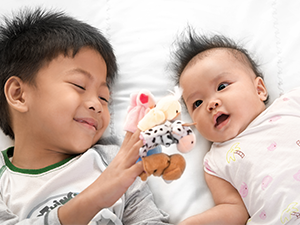Animals Pretend & Play – Baby
 Babies are attracted to the faces on toy animals and are ready for simple pretend play from a young age.
Babies are attracted to the faces on toy animals and are ready for simple pretend play from a young age.
Did you know?
Babies will try to copy you making animal sounds from around 8 months of age. Copying your sounds is an important step towards using words themselves.
Add language
You could point out and name the same animals in pictures, with toy animals and with real animals e.g. a picture of a dog, a toy dog, a pet dog. Learning to recognise that words, pictures and toys represent real things is important for learning language for talking and later for reading and writing.
Other development
Chunky toy animals give babies practice at grasping and moving objects with irregular shapes. This helps build their fine motor skills.
Handling toy animals made from different materials gives your baby valuable experiences of different sensations of touch. Toy animals can be soft and furry to feel. Some can be with soft, textured plastic or with hard, smooth plastic. Your baby is learning about their world through their sensory experiences.
Soft toy animals often become comfort items for babies and young children. This can help them learn self-soothe which is the beginning of them managing their own activity levels and emotions. This is important for their emotional development.
Across the ages
All the activities listed on our “Play Ideas” page can be applied across different age groups. See how Animals – Pretend and Play can be fun for toddlers, children and playgroups.
Activities listed under “baby” are suitable for children under 12 months. This age is largely about babies exploring their own bodies and the world around them from the safety of a close relationship with their caregiver.

